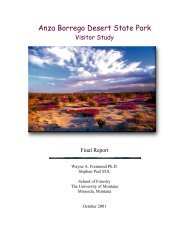Final Mitigated Negative Declaration and Response to Comments
Final Mitigated Negative Declaration and Response to Comments
Final Mitigated Negative Declaration and Response to Comments
You also want an ePaper? Increase the reach of your titles
YUMPU automatically turns print PDFs into web optimized ePapers that Google loves.
III.<br />
AIR QUALITY.<br />
ENVIRONMENTAL SETTING<br />
Lake Tahoe sits in a high-elevation basin bounded by the Sierra Nevada Mountains <strong>to</strong> the west<br />
<strong>and</strong> the Carson Range <strong>to</strong> the east. The source of the air pollutants that threaten Lake Tahoe<br />
water clarity are created both locally <strong>and</strong> from outside the basin. Local sources are the most<br />
significant contribu<strong>to</strong>r of pollutants <strong>and</strong> include urban <strong>and</strong> forest wood smoke, vehicle exhaust,<br />
<strong>and</strong> dust (Gertler et al. 2006). Air pollution sources from outside the basin include Sacramen<strong>to</strong><br />
<strong>and</strong> San Francisco Bay Area urban pollutants <strong>and</strong> smoke from wildfires.<br />
The Lake Tahoe Air Basin is comprised of the eastern portions of Placer <strong>and</strong> El Dorado<br />
Counties in California <strong>and</strong> the western portions of Washoe, Douglas, <strong>and</strong> Carson City Counties<br />
in Nevada that encompass the Lake Tahoe hydrographic basin (CARB 2008). Emerald Bay<br />
State Park (SP) is within the jurisdiction of the El Dorado County Air Quality Management<br />
District (EDCAQMD 2010).<br />
Climate<br />
The climate of the Lake Tahoe region is generally Mediterranean, but is modified by<br />
<strong>to</strong>pography <strong>and</strong> geography. It is characterized by relatively warm, dry summers, interrupted by<br />
occasional lightning s<strong>to</strong>rms, <strong>and</strong> cold, wet winters with variable precipitation, mostly falling as<br />
snow (O’Hara et al. 2007). Weather conditions can change rapidly as upper level wind<br />
currents <strong>and</strong> pressure systems in the western states shift locations <strong>and</strong> both dry <strong>and</strong> wet<br />
frontal systems move through the mountainous terrain.<br />
The <strong>to</strong>pographic condition of the Lake Tahoe Basin surrounded by high mountains has a<br />
tremendous influence on local weather conditions <strong>and</strong> the resulting air quality. Lake Tahoe<br />
experiences both surface-based <strong>and</strong> subsidence inversions. Surface-based inversions form<br />
when cool air settles down in<strong>to</strong> the basin replacing the warmer surface air, resulting in the<br />
warm air rising <strong>and</strong> creating a lid over the basin, which traps the air below. These surfacebased<br />
inversions generally begin late evening <strong>and</strong> lift during mid-morning as the sun warms<br />
the atmosphere. Subsidence inversions result from high pressure centered over the region.<br />
The high pressure compresses the atmosphere, creating a lid over the basin. These high<br />
pressure systems are common during the summer <strong>and</strong> fall, <strong>and</strong> may persist for long periods.<br />
Air Quality Designations<br />
Public l<strong>and</strong> owners <strong>and</strong> managers within El Dorado County are subject <strong>to</strong> air quality planning<br />
programs required by the federal Clean Air Act of 1970 (CAA), its 1990 amendments, <strong>and</strong> the<br />
California Clean Air Act of 1988 (CCAA). Both the federal <strong>and</strong> state clean air statutes provide<br />
for ambient air quality st<strong>and</strong>ards related <strong>to</strong> air pollutants, timetables for progressing <strong>to</strong>ward<br />
achieving <strong>and</strong> maintaining ambient st<strong>and</strong>ards, <strong>and</strong> the development of plans <strong>to</strong> guide air<br />
quality improvement efforts by state <strong>and</strong> local agencies. Ambient air pollutants called criteria<br />
pollutants are pollutants for which acceptable levels of exposure can be determined <strong>and</strong> for<br />
which an ambient air quality st<strong>and</strong>ard has been set.<br />
The United States Environmental Protection Agency (USEPA) is responsible for setting<br />
National Ambient Air Quality St<strong>and</strong>ards (NAAQS) <strong>and</strong> established national area designations<br />
Asian Clam Control Project IS/MND<br />
Emerald Bay State Park<br />
California Department of Parks <strong>and</strong> Recreation<br />
20
















